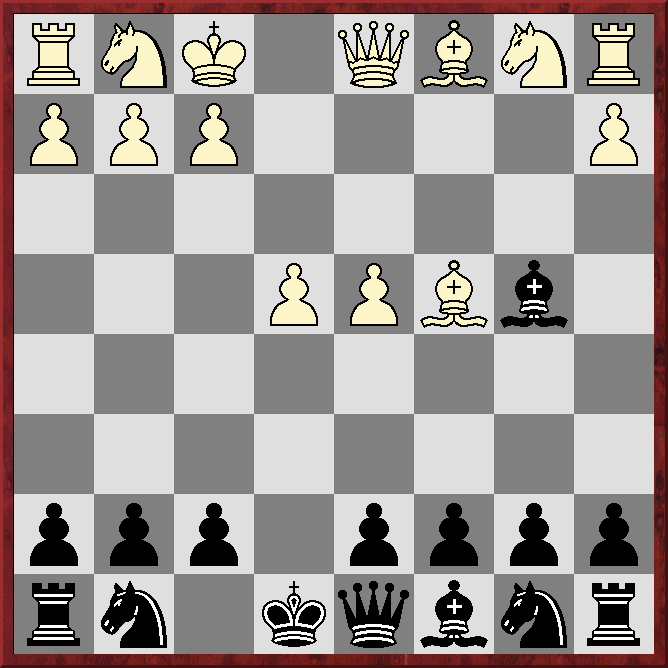Notes in italics are algebraicised from the book.
George MacDonnell - Samuel Boden
British Chess Association Challenge Cup (London) 1869*
Bishop's Opening
1.e4 e5 2.Bc4 Bc5 3.b4!?
A fancy opening, the invention of the Scotch master himself.
This gambit, a sort of Accelerated Evans, is better than it may appear. Wilhelm Steinitz was a keen user of it in simuls.
3...Bxb4
Or 3...Bb6 4.a4 (if not 4.Bb2 d6, or 4.Nf3 d6 5.d4 etc) a5 5.b5 Nf6 6.d3, and White has a strong game.
4.c3
After 4.f4 ("MacDonnell's Double Gambit") Black's best plan, instead of acceptance by 4...exf4 5.Nf3 etc, is to advance in the centre by 4...d5 5.exd5 e4 6.Ne2 Nf6 etc.
Stockfish14.1 and Komodo12.1.1 reckon f4 is at best dubious and probably a mistake, although it is how Steinitz liked to play the opening.
4...Bc5 5.d4
White tries to outflank the enemy in preference to reverting to the "Evans Gambit" formation by 5.Nf3 Nc6 6.d4 etc.
5...exd4 6.cxd4 Bb4+ 7.Kf1!?
Threatening 8.Qb3 or 8.Bxf7+ Kxf7 9.Qb3+ followed by ...Qxb4(+).
*****
*****
*****
*****
7...Ba5?!
If 7...Be7 [then] 8.Qb3. But 7...Nc6 brings another piece into the lists, eg 8.Qb3 Qe7 etc, or 8.d5 Ne5 etc.
The engines reckon best is 7...Ne7!?, eg 8.Qb3 d5! 9.Qxb4 (9.exd5 Bd6; 9.Bxd5 Nxd5 10.exd5 a5) 9.Qxc4 b6!?
8.Qh5
To be considered is the continuation 8.Bxf7+ Kxf7 9.Qh5+ g6 10.Qxa5, also dislodging the hostile king.
*****
*****
*****
*****
8...d5
The only possible parry.
9.Bxd5 Qe7 10.Ba3 Nf6
Black always finds the right answer.
*****
*****
*****
*****
11.Bxf7+?
The game is roughly equal after 11.Bxe7 Nxh5 12.Bg5, but 11.Qg5! is best, according to the engines, eg 11...Bb4 12.Qxg7 Rf8 (or 12...Rg8 13.Bxb4 Rxg7 14.Bxe7 Nxd5 15.Ba3) 13.Bxb4 Qxb4 14.Qxf6 Qb2 15.Nf3 Qxa1 16.Ke2, when White has a pawn and an attack for the exchange.
11...Qxf7 12.Qxa5 Nc6 13.Qa4!?
The engines prefer 13.Qe1 or 13.Qb5, albeit giving Black at least the upper hand.
13...Nxe4
Re-establishing the numerical balance, but dynamically Black's chances are superior.
14.Nf3 Bd7
14.Nf3 Bd7
Threatening 15...Ne5, and preparing to castle on the queenside, his only chance.
15.Nbd2 Nxd2 16.Nxd2 0-0-0
This contains the astute threat 17...Nxd4 18.Qxa7 (18.Qxd4 Bb5+, winning the queen) Bb5+ 19.Ke1 (or 19.Kg1 Ne2+) Qe8+ 20.Kd1 Ba4+ 21.Kc1 Ne2+ 22.Kb1 Qg6+, forcing the mate.
17.Rb1 Qd5
Throwing the whole weight of the queen into the fray, in preference to spasmodic enterprises such as 17...Nxd4 18.Qxa7 Bb5+ etc, or 17...Qxa2 18.Qb5 b6 etc.
18.Nf3 Bf5 19.Rd1 Rhe8 20.Bc5
In order to guard, as far as possible, the pawns at d4 and a2. He expects only 20...b6 (which would be telling enough), but Black has prepared a far more ingenious and skilful scheme to settle the issue. White's battered position is already beyond repair. If, for instance, 20.Qb3 [then] 20...Qxb3 21.axb3 Bc7 wins a vital pawn, and if 20.h4 [then] 20...Bg4 etc.
*****
*****
*****
*****
20...Qxf3!
A "break-up sacrifice" of the queen.
As the book annotations point out, 20...b6 is also very strong, as are several other moves, but the text is the prettiest finish.
21.gxf3 Bh3+ 22.Kg1 Re6
Threatening a fatal check.
23.Qc2
Watching the fateful square (g6), but another and diabolical machination puts an end to all resistance.
23...Rxd4!?
Most elegant.
Again Black had several ways of converting his advantage, including 23...Ne5 and 23...Nxd4.
24.Bxd4 Nxd4 0-1
*The year is given in the book as 1865, but 1869 seems correct.




No comments:
Post a Comment